The Media's 'Far-Right' Obsession
Research shows the media is far more concerned about right-wing extremism than its left-wing counterpart.
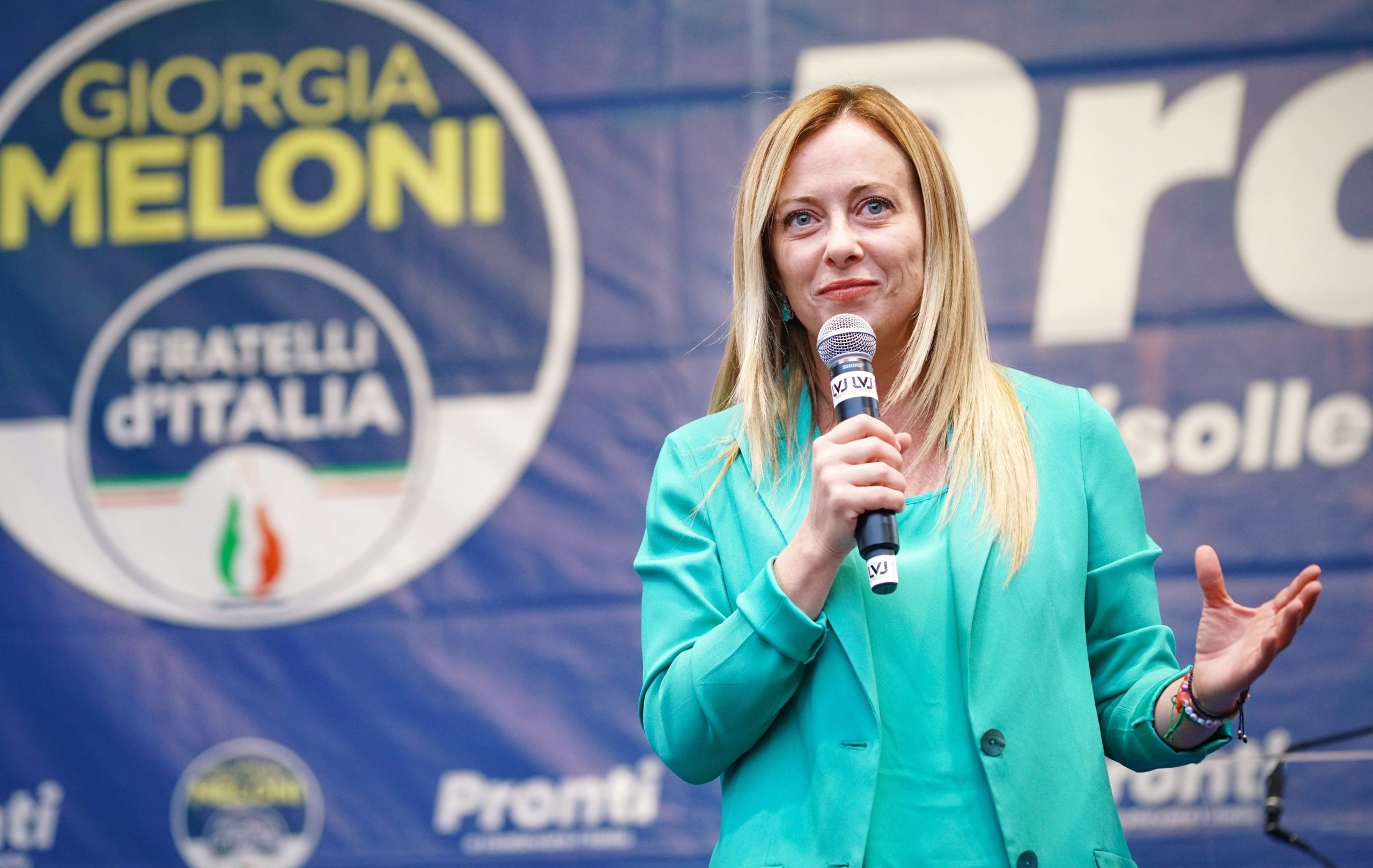
Giorgia Meloni’s recent victory in the Italian national election prompted an outburst of references to far-right political extremism in American and European news media. Given the challenge of establishing a politically neutral reference point for determining precisely what counts as political extremism, it is natural to wonder whether media outlets are equally likely to denounce ideological extremism from the left as from the right. Our recent research shows that when it comes to calling out political extremism, media figures are much more likely to decry political extremism from the right than from the left. We have the data to prove it.
In our study, we conducted data analysis of millions of news and opinion articles from popular U.S. and U.K. news media outlets and quantified the media’s use of extreme qualifiers such as "ultra," "extreme," or "far" when speaking about right and left political orientation. That is, we counted the number of times different news outlets mentioned terms such as "far-right," "far-left," "radical right," "radical left," "right-wing extremism," "left-wing extremism," etc. Overall, we found that most mainstream news-media outlets mention the far right much more often than the far left.
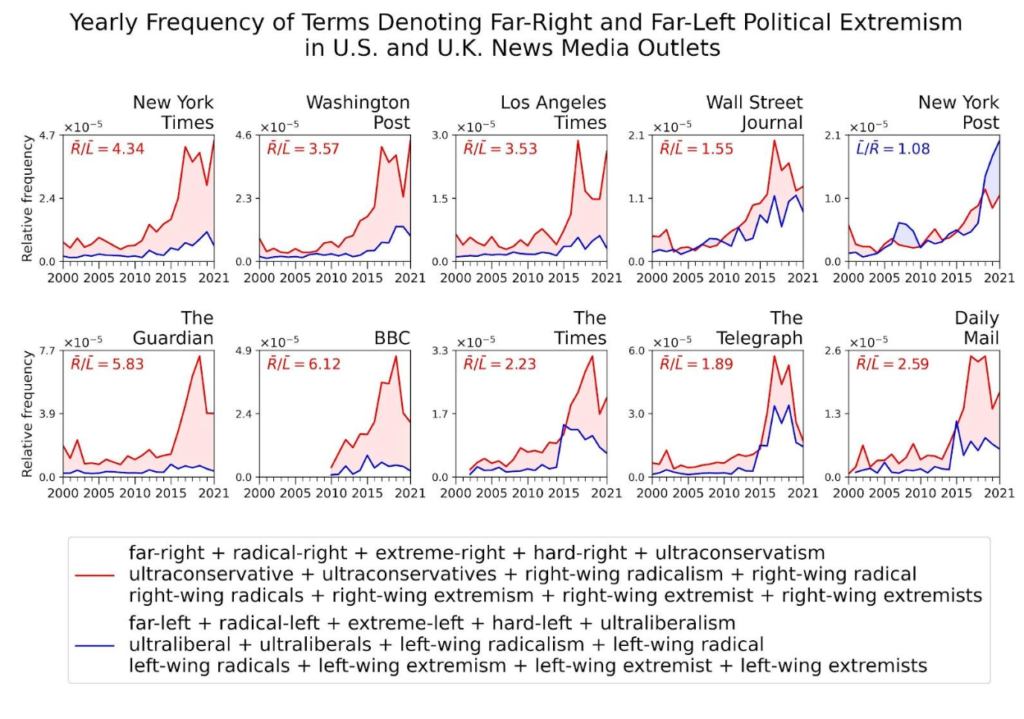
We also found that references to both the far right and the far left have been increasing across American and British news outlets since around 2010. In the U.S., there is also a general trend towards emphasizing extremism from the political out-group. That is, both left- and right-leaning outlets tend to mention political extremism from the opposite political tribe more often than that from their own, but the pattern is milder in right-leaning outlets. In fact, right-leaning news outlets are about two times more likely to mention extremism from the right than left-leaning news outlets are to mention left-wing political extremism. U.S. centrist outlets display similar dynamics to left-leaning ones.
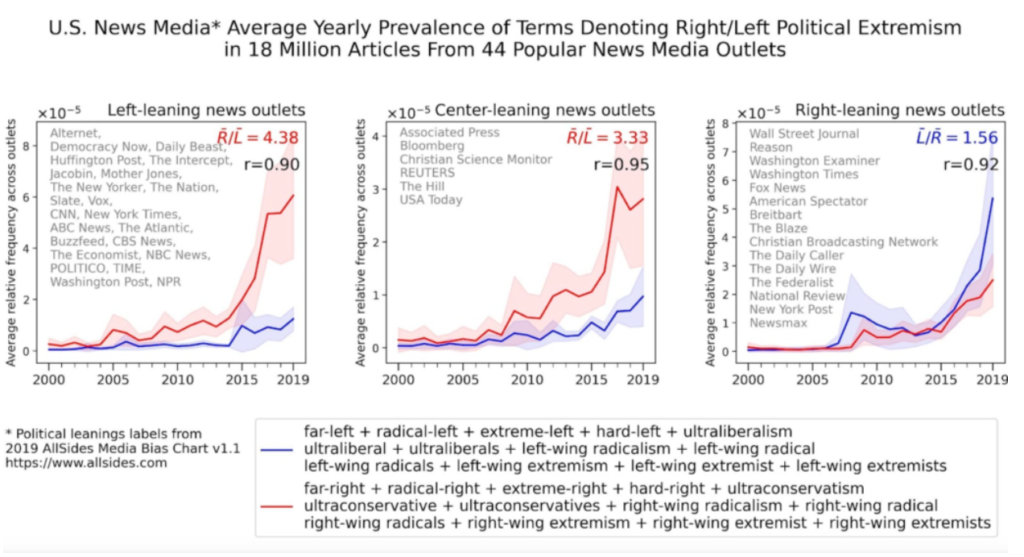
In the U.K., all ten of the popular news outlets analyzed, including the right-leaning ones, mention the far right more often than the far left.
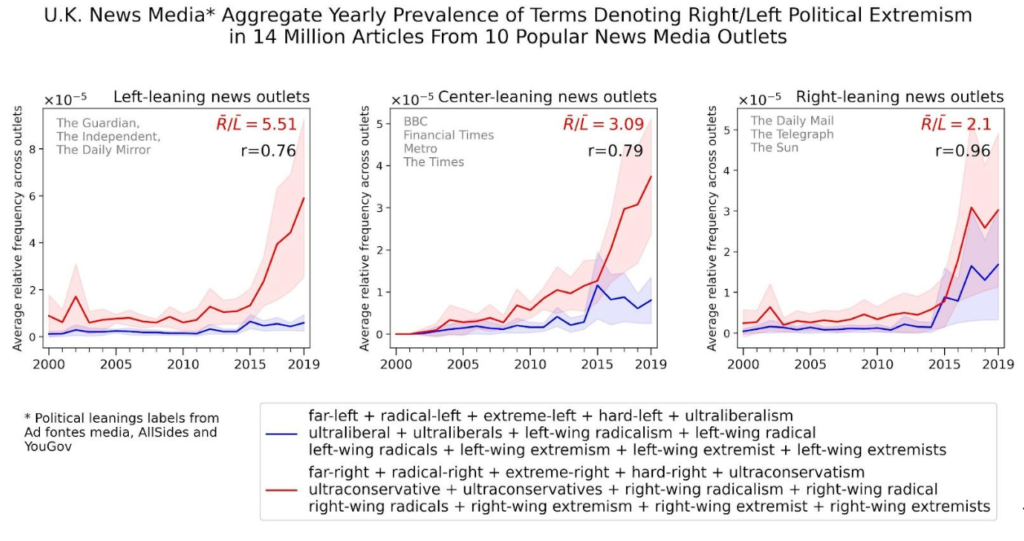
Could the emphasis on an extreme right wing rather than left-wing extremism simply reflect the fact that there is more far-right than far-left activity in the United States and the U.K.? This is certainly plausible and consistent with the recent growth of electoral support for so-called populist right-wing political parties and candidates in North America and Europe. Others have also hinted, however, at rising far-left activity in Western societies and mutual left-right radicalization.
Additional results in our published work are also inconsistent with the hypothesis that the higher prevalence of far-right terminology in news media can be exclusively explained by a recent rise in far-right activity. For instance, in the 1970s, the New York Times used references to far-right and far-left political extremism at a comparable rate. Since the 1980s, however, both the New York Times and the Washington Post have used terms suggestive of right-wing extremism consistently more often than terms suggestive of left-wing extremism. That is, the media’s disparate focus on right-wing political radicalism is not new.
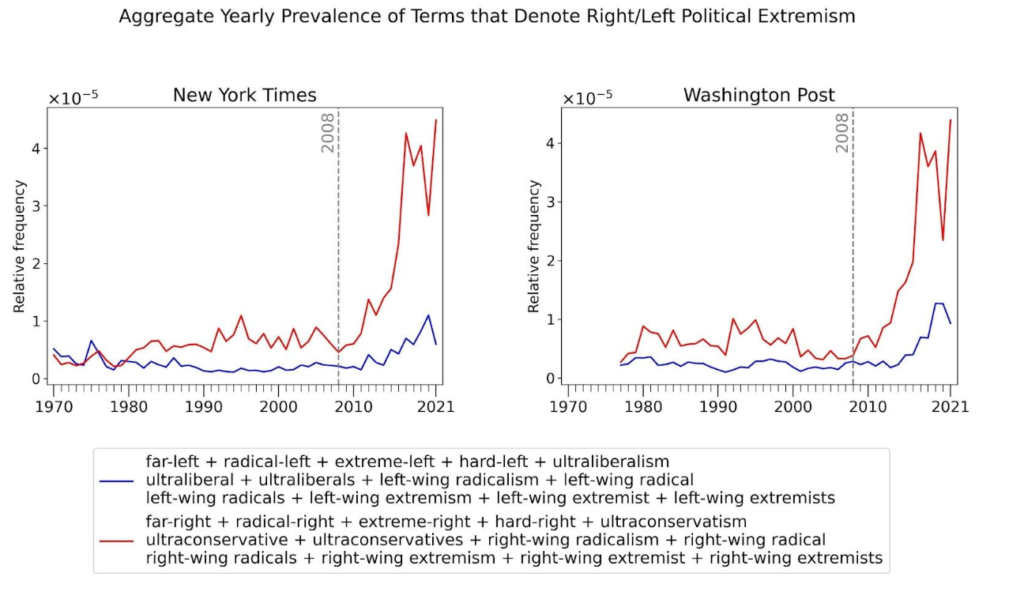
The political success of Donald Trump in 2016 has also been suggested as a distinct break from the past that could account for the acute surge in media focus on right-wing extremism. However, our analyses show that increasing media mentions of right-wing extremism began well before the political rise of Trump, with mentions of right-wing extremism between 2008 (when Barack Obama won for the first time the U.S. presidential election) and 2014 (the year prior to the 2015 entrance of Donald Trump to the U.S. political scene) rising by 243 percent and 359 percent in the New York Times and Washington Post, respectively.
While it is indisputable that groups labeled "far right" have been increasingly prominent in U.S. and European politics, it is also plausible that the center of gravity in established media newsrooms, as in other professions of cultural influence, has been shifting leftwards, especially as prestige news-media companies are increasingly organized and edited by graduates from elite universities, who tend to hold socially liberal beliefs that might shape their choice of political adjectives.
Previous surveys have indeed identified such a skew; left-leaning journalists in the U.K. outnumber their right-leaning counterparts by a 2:1 ratio. The disparity is starker among young journalists, where surveys show a 3:1 left-leaning-to-right-leaning ratio. A similar study in the United States found a 4:1 Democrats to Republicans ratio within the journalistic profession as of 2013. This disparity appears to have become more acute over time; in 1982, the ratio was only 2:1. A more recent study quantified the ideological leanings of journalists across 17 Western countries. In all of them, with the exception of Slovenia, the average journalist displayed a clear left-leaning bias compared to the average country voter.
The ideological imbalance among journalists, in combination with a society-wide shift away from fact-based standards of objectivity, could be leading some journalists to label attitudes and groups they simply dislike as politically extreme. This is to a certain extent unsurprising. It might be natural for left-leaning writers to be more concerned about the far right than their more adjacent far left, while those on the right might be more concerned about the far left than the far right. And, since most journalist are left-leaning, there would hence be the potential for an overall net media bias against anything right of center.
Consequently, the most parsimonious explanation for the unbalanced mentions of far-right and far-left political extremism in the media is journalists' well-documented left-leaning political slant, which potentially skews mentions of political extremism towards their political adversaries. But the immense cultural power of the media and the possibility that its ideological imbalance is shaping journalistic content should trigger reflection about the extent to which news-media content can accurately portray current events—especially those with political connotations.
Our study also found that the surge of rhetoric suggestive of political extremism in news media tracks similar rises of terms often used to denounce prejudice (racism, sexism, homophobia, Islamophobia, anti-Semitism, etc.) as well as terms commonly associated with social-justice discourse (diversity, inclusion, fairness, equality, etc.). In the figure below, we used a statistical analysis metric named "min-max scaling" of underlying frequencies to assess not the overall prevalence of terms but when, on average, a set of terms is used at minimum and maximum levels over a period of time. The red and blue lines below show min-max normalized mentions of right or left political extremism in news media. Both trends display very similar dynamics to the orange and green lines tracking prejudice language and social-justice terminology in the same media organizations: namely, rapid and highly correlated growth after 2010.
Subscribe Today
Get daily emails in your inbox
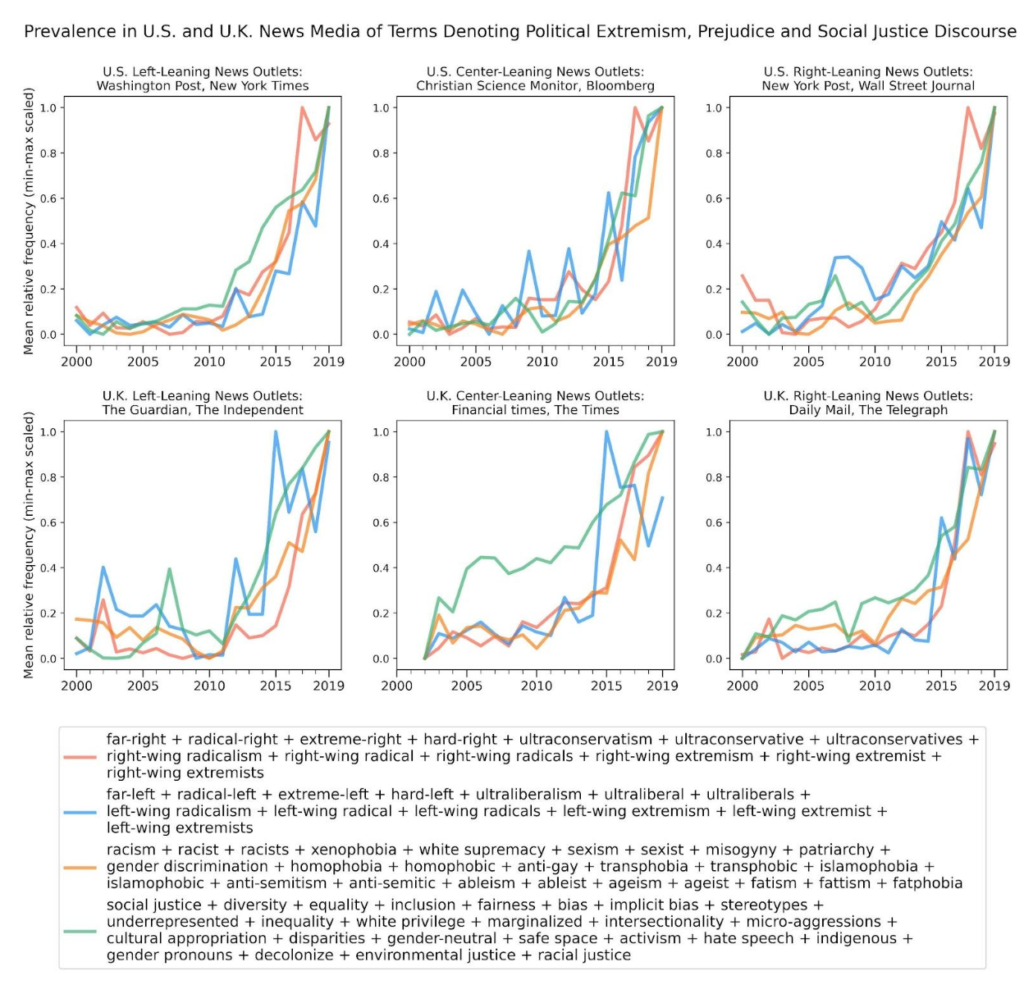
The potential connection in news-media content between calling out political extremism, denunciations of prejudice, and social-justice discourse merits further scrutiny. Due to the methodological limitations of our study, we cannot conclusively establish the causes underlying the disproportionate focus of news media on the far right compared to the far left. But interpreting our results in combination with the well-documented left-leaning political slant of journalists suggests that the reported surge of extremist activity, especially far-right extremism, may be as much a reflection of journalists' political sensibilities as the facts on the ground.
Comments